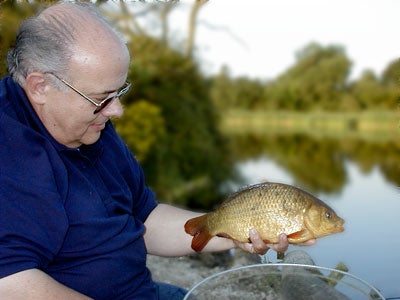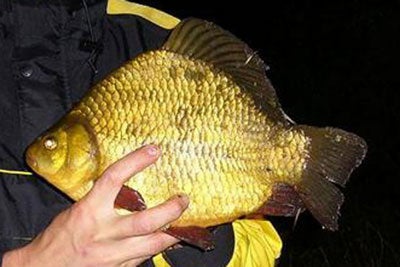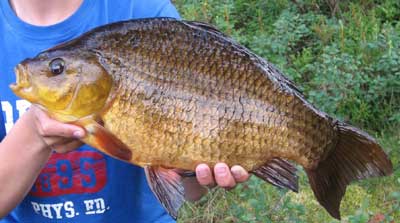Crucian Carp – ‘of Variable Shape’EVEN THE EARLIEST writers on Crucian Carp describe it as a fish “of variable shape”. Its close relative, the Goldfish, is a shape-shifter – just think of the different fancy varieties. Similarly, selective breeding in the Common Carp has resulted in several well-marked races, strains and varieties. It seems likely, then, that the Crucian Carp has the same potential, though I haven’t been able to trace any examples of selective breeding with Crucians.
It’s been known for centuries that as well as the deep, flat-bodied form of Crucian, there is a lower-backed, more cylindrical form. In nineteenth and early twentieth century, this second strain or variety was called “Prussian Carp,” a name that’s caused a lot of confusion ever since. In Scandinavia, they described them as “lake” Crucian and “pond” Crucian respectively. In the wild, most fish are of intermediate shape, but the extremes are quite remarkably different, so much so that there was much discussion in scientific circles about whether they were in fact two species. In all fish, certain traits seem to develop in response to environmental and genetic influences. The most obvious case is that of carp but there are differences in shape and colour in all species. Adaptable shapes In the case of the Crucian Carp, as a general principle, in waters where there is an abundance of food and plenty of room, the fish tends to be deep in the body; where food is scarce and competition intense, the fish has a lower, more cylindrical shape. If conditions change, the body shape changes, sometimes surprisingly rapidly. It has been suggested by scientists that this is because the more streamlined shape makes for more efficient foraging, important in competitive situations. When a fish population increases or when food supplies become less, deep-bodied Crucians are at a disadvantage and must revert if they are to survive; this they will do over just one generation. Because Crucians are prolific breeders they can quickly become stunted and low-backed. Remove the competition by netting, say, and the Crucian Carp quite quickly becomes deeper-bodied once more. Gape defence Another factor affecting body depth is the presence of predators. Laboratory experiments have shown that Crucian Carp respond to the presence of predators by developing – again, surprisingly quickly – a deeper body as a defence. Their weight is re-distributed vertically to make it more difficult for pike or big perch to grab them: scientists call it “gape defence”.
High-backed Crucians are relatively scarce in the UK In the UK, of course, conditions are different. We don’t have many big, wild waters populated by Crucian Carp. I suppose our gravel pits and larger estate lakes are the closest thing; the Norfolk Broads, Scottish lochs and Irish loughs do not naturally contain Crucians, as far as I know. Crucians stocked in our smaller waters will, as a general rule, breed abundantly and remain modest in proportions as a result of what the scientists call intra-specific competition: ie too many Crucians relying on the same, limited food resources. The high-backed form will occur where suitable predators exist or where numbers of Crucians are artificially reduced in some other way. It is for this reason, I suggest, that the high-backed Crucian has always been relatively scarce in the UK, while the lower backed form is plentiful (see Donald Leney’s correspondence with Richard Walker in “Drop Me A Line” 21). There seems to be a tendency for the biggest Crucians to lose depth. This may be because they have become too large to be at risk from predators and so no longer need the protection that extra depth gives. Equally possible is that these are the oldest fish anyway and that losing depth is part of the aging process. My own oldest Crucians are about 20 years of age and are lower-backed than the younger fish, even though many of the original stock are now between 3lbs and 4lbs in weight. They may be nearing the end of their natural life span, which is supposed to be about 20 years in the wild. Time will tell. Genetic factors can also influence body shape In my experience of my closely monitored and DNA-tested Crucian Carp populations, genetic factors can also influence body shape. For example, all of the thousands of Crucian Carp I have bred over the last 34 years originate from 17 brood fish introduced to an isolated field pond in 1972. They have mostly been raised in small waters as part of a mixed population, but with no predatory fish apart from small perch. This seems to have resulted in a strain disposed to be of low profile and it may be that only selective breeding would restore the traditional shape. It may be, of course, that introducing pike would cause a change in body shape. Up to now, I haven’t tried this because I would rather control numbers by netting, so that I can sell the younger fish to increase the income of the estate. Therefore, in the ponds I look after, body depth is controlled by space and food available, not the presence of predators. Because of the certain degree of control that regular netting allows, I have been able in one 2-acre pond to raise Crucians in relatively uncrowded conditions, where an increase in body depth might well be expected. However, although fish have been caught up to 4lbs, the dorsal profile remains stubbornly low, as the photo shows. From next winter, though, I intend to stock one 2 acre pond with pike and to monitor the body profiles of the Crucians there in comparison with those in the adjacent pond, where there will be no large predators. If there is a resulting difference it should be detectable by the summer of 2008. All of what I’ve written above ignores hybridisation, which I’ll deal with separately if the editor permits. It should be clear, though, that not all big Crucians will have the same body profile as, say, the splendid Yateley strain and that record claimants should not be judged on that pattern alone. |
Welcome!Log into your account













